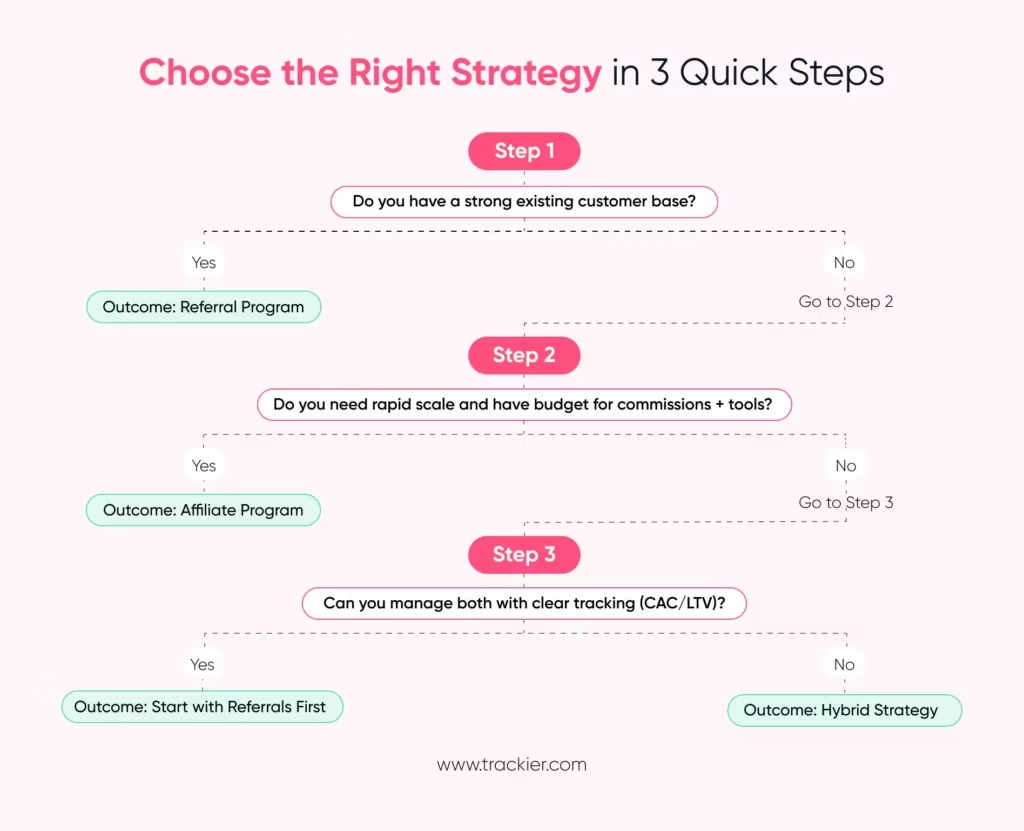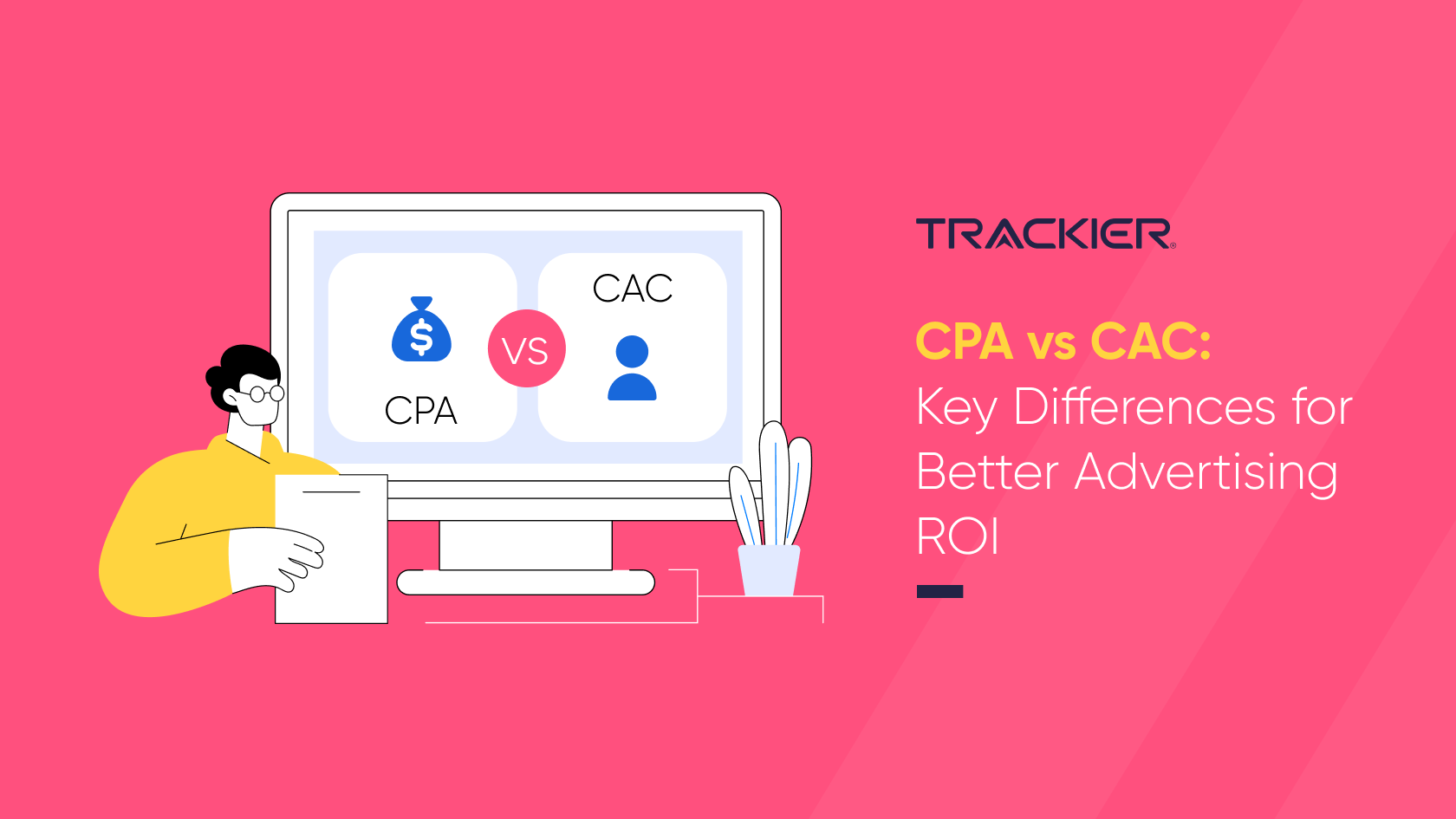You’ve probably heard of referral vs affiliate marketing and wondered what separates them.
Well, you are not alone.
Many marketers get confused between “referral vs affiliate marketing” because on the surface they look similar: people promoting your product and earning rewards. If you run a brand or a business, picking the wrong approach can cost money, time, and trust.
In this guide, we’ll walk you through referral vs affiliate marketing clearly.
You’ll learn definitions, metrics, strengths, challenges, and when each fits best. By the end, you will have a proper understanding about which strategy works best for your specific business type.
What is the real difference between referral vs affiliate marketing?
When people ask referral vs affiliate marketing, they usually mean: How do these programs differ in who promotes, how rewards are given, and what scale you can expect.
Definition and core concept
Referral marketing relies mostly on existing customers promoting your brand to people they know.
These are trusted relationships, friends, colleagues, peers. On the other hand, affiliate marketing depends on external partners (bloggers, influencers, content creators) who promote in exchange for commission.
So with referral you lean on trust, whereas with affiliates you lean on reach.
How referral marketing works
You might give customers referral links or codes.
For instance, Dropbox used to offer extra storage space when a friend joined using your link.
PayPal once gave both sides a bonus when someone signed up using a referral. The rewards could be credits, discounts, loyalty points.
The motive is to encourage word of mouth. Tracking comes from referral codes or invite systems.
How affiliate marketing works
Affiliates get unique links, trackable via dashboards.
They promote your product through blogs, videos, social media, or email. When someone clicks that link and converts, the affiliate earns commission.
Networks like Amazon Associates or others supply dashboards that show clicks, conversions, and commissions. You pay based on performance.
Key metrics for referral vs affiliate marketing
To compare referral vs affiliate marketing you measure for each:
- Conversion Rate, % of referred/affiliate clicks that turn into buyers
- Click-Through Rate (CTR) of referral links or affiliate links
- Lifetime Value (LTV) of customers acquired through referrals vs through affiliates
- Number of Referrals and Affiliate Sales over time
- Customer Acquisition Cost (CAC), specifically how much you spend per referral vs per affiliate conversion
You’ll need dashboards or tools that give real-time reporting. That helps you see trends, spot fraud early on, and adjust incentives.
| Difference | Referral Program | Affiliate Program | Key Takeaway |
| Promoter / Audience | Existing customers, users who already love you | External marketers/influencers seeking commissions | Use referral programs when your product already has satisfied customers |
| Reward / Motivation | Discounts, loyalty points, perks, sometimes cash | Monetary commission, often % of sale or fixed fee | Rewards aligned with what motivates target promoters |
| Scale / Reach | More limited, grows with customer base | Much wider, global or across niches | Affiliate marketing scales faster, referral grows more organically |
| Cost & Risk | Lower risk, lower CAC, simpler tech and oversight | Potentially higher payout, requires fraud monitoring & platform cost | Determine your budget and risk tolerance first |
| Tracking & Fraud | Easier to monitor since fewer promoters, trust is higher, less fraud risk | Need dashboards, affiliate networks, possible misrepresentation & fraud | Invest in detection/monitoring tools for affiliate side |
| Speed of ROI | Slower initially, depends on existing customer engagement | Can see quicker returns especially if affiliates have big reach | If you need fast scale, affiliates may be better early on |
| Trust & Brand Control | High trust, since people trust friends, the message tends to be more authentic | Less control over message, affiliates might vary in quality | Use referral when trust and brand voice matter a lot |
Let’s understand these in depth:
Audience and promoters
In referral vs affiliate marketing, audience source differs. Referral programs use customers who already know your product. Affiliates are external folks who may or may not have used it. That means in affiliate marketing you must invest more in partner screening, content guidelines, and sometimes compliance.
Motivation and rewards
In referral marketing rewards are often friendly: discounts, bonus credits, loyalty perks. In contrast affiliate program rewards are monetary, such as cash commissions based on sales or leads. Because affiliate reward is often tied directly to revenue, the partner expects compensation that aligns with how much they promote and sell.
Marketing reach and scale
Referral marketing depends on how many customers you already have and how active they are telling others about you. It tends to spread more slowly but with stronger trust. Affiliate marketing allows you to tap into existing networks, content creators, niche sites, influencers. You can scale quickly, globally even, provided your affiliate network is good.
Cost and ROI considerations
Referral programs often cost less per acquisition. Your spend is mostly incentive fulfillment and some tech. Affiliate programs require more setup: affiliate platform fees, management, fraud prevention, commission payouts. On the flip side, affiliates could bring in high volume, so ROI might be high if managed well.
Metrics and reporting differences
Referral programs allow cleaner tracking per user, you know who referred who, you can map behavior of referred customers. Affiliate programs rely heavily on dashboards, external tracking, possibly multiple attribution models. You’ll also need to watch for click fraud, fake leads, and cookies expiring.
Speed of impact vs long-term value
Referral often builds over time: first you need customers who love your product, then they tell others. Affiliates can deliver faster results because affiliates might already have traffic streams. But affiliate-acquired users may have lower retention or lower LTV if too many incentives or less alignment.
Trust and brand control
Trust is higher in referrals because recommendations come from someone the potential customer already knows. In affiliate marketing you may sacrifice some consistency of message, quality of recommendation, or level of transparency. That can affect how converts perceive offers.
Which businesses should use referral vs affiliate marketing, who wins in what scenario?
Here’s how to choose depending on the business model, goals, metrics you care about.
Best fit for referral marketing
If you run SaaS with high retention, or subscription-based product, referrals are powerful: existing customers share with colleagues, peers. Small perks or credits can boost loyalty. In eCommerce, when repeat business matters, referrals help bring back customers and also generate new ones who already trust the brand through friends. For B2B, referrals from satisfied clients can be priceless. Those leads tend to convert at higher rates.
Best fit for affiliate marketing
Affiliate programs shine when you need scale, or when you want exposure in niche verticals where affiliates already have authority. Also when you can track ROI cleanly, and when a commission model aligns with your margins. If you sell physical products or want traffic globally, affiliate partners can bring in buyers in places you might not reach via your own channels.
Metrics That Truly Matter, and Why
When you’re weighing referral vs affiliate marketing, your decision should rest on several key metrics that reveal both short-term results and long-term value.
Below are four metrics every marketer must track in 2025:
Customer Acquisition Cost (CAC) and Relative Cost Efficiency
CAC is the total cost to acquire one new customer via a specific channel. Lower CAC means better cost efficiency. Referral programs tend to have lower CAC because you leverage advocates (existing customers) rather than paying commissions or ads. Affiliate programs, while capable of high volume, often carry higher CAC due to commissions, partner fees, and content promotion costs.
Include all costs including rewards, software, tracking tools, affiliate payout, ad spend and then divide by the number of acquired customers via that channel over a period (e.g. a month).
Real Life Example: A recent study found that established referral programs reduced CAC by 30-50% as compared to other acquisition methods.
Lifetime Value (LTV) and Retention Differences
LTV measures how much revenue a customer will generate over the lifetime of their relationship with your business. Referral-acquired customers tend to have higher retention, buy more often or refer others themselves. Affiliates may drive initial sales but sometimes weaker retention.
Track cohort behavior (referral vs affiliate) for retention rate, repeat purchase rate, average order value over time, churn.
Real Life Example: Reports state that customers obtained via referral show 16-25% higher LTV than those from other channels in 2025.
Conversion Rates, Activation, and Engagement
How many prospects become customers (conversion rate), how quickly they use or adopt your product (activation), and how engaged they stay (engagement rate) matter because they affect downstream revenue. A referral customer often converts after fewer touchpoints; an affiliate-sourced lead may require more nurturing.
Look at funnel metrics: share rate, click-through rate (CTR), activation (first use or first purchase), repeat activity or usage over time.
Real Life Example: 2025 data for eCommerce brands shows median referral conversion rates between 3-5%, with top quartile reaching 8%+.
Revenue Per Channel and Incrementality
Revenue per channel tells you how much income each acquisition source is bringing in net of costs. Incrementality is especially important for affiliate marketing — you need to understand whether affiliate sales are truly incremental (i.e. would not have happened without the affiliate).
Calculate total revenue from each channel minus the costs (commissions, discounts etc.), then compare. Use attribution models or experiments (with control groups) to test incrementality.
Real Life Example: A 2025 affiliate marketing trend report highlights that brands are increasingly applying metrics such as assisted conversions and LTV to avoid paying affiliates for sales that would have occurred anyway.
How to Use These Metrics Together
- Begin with benchmark data: see what CAC, conversion rate, and LTV look like in your industry (e.g. eCommerce, SaaS) so you have realistic targets.
- Measure side-by-side trials: run a small affiliate campaign and referral program in parallel for a month or two. Compare net CAC, LTV, engagement.
- Track over time: sometimes referral looks slow at first but gains momentum; affiliate might shine early but decay if partner quality or churn is bad. Use dashboards with cohort analysis.
By centering your decision with current, channel-specific metrics, you align strategy with measurable business outcomes.

Can affiliate marketing and referral marketing work together, and how?
Yes, these strategies don’t have to be mutually exclusive. You can combine “referral marketing and affiliate marketing” to harness both trust and scale.
Combined strategy benefits
Using both gives you trust built via referrals plus expanded reach through affiliates. Referrals tend to give higher retention, affiliates often bring volume. Together you maximize potential: trusted customer promoters offer authenticity, affiliate partners broaden exposure.
How to implement a combined strategy
Here’s how you can set up a dual approach:
- Maintain separate but unified dashboards, one for referral metrics, one for affiliate metrics. Then roll up into one performance view for overall impact.
- Define rewards distinctly for customers (referral rewards) and for affiliates (commission). Be transparent so both groups understand what they’ll earn.
- Use alignment in messaging. For example, an affiliate who is also a customer could participate in both programs, offer differentiated rewards.
- Monitor in real-time. Watch which program is bringing higher LTV, which has lower CAC, and adjust budget / incentives accordingly.
What are the challenges of referral vs affiliate marketing?
Every program has trade-offs. Understanding these helps you avoid pitfalls.
Referral marketing challenges
- If your customer base is small or not engaged, referrals won’t take off. Without strong product satisfaction, customers won’t advocate.
- Incentives that are too weak don’t motivate, incentives that are too rich cut into margins. Finding the sweet spot takes testing.
- Tracking accurately can be harder if referrals are informal or via offline channels, real-time visibility may lag.
Affiliate marketing challenges
- Risk of fraud: fake clicks, cookie stuffing, or false claims. You will need fraud detection and strict terms.
- Message control is less, affiliate content might misrepresent your product or violate compliance. You’ll need clear policies.
- Affiliate management requires infrastructure: dashboards, partner vetting, payments, legal/FTC disclosures.
How do you decide between referral vs affiliate marketing for your business?
Here’s a decision framework to help you choose wisely.
Key decision factors
Ask yourself:
- What are your primary goals? Is it growth, revenue, loyalty, or awareness?
- What is your budget and resources for partner management, payout, tech?
- Who is your target audience? Do they trust peer recommendations or are they influenced more by expert reviews, content creators?
Quick metrics checklist
Use this checklist to test which path might serve you better:
- If your CAC is already high, referrals may lower it.
- If your LTV of customers from referrals is substantially higher than other channels, referrals should be prioritized.
- If affiliates are bringing traffic but poor retention, you might adjust affiliate quality controls.
- If you find both are performing, scale both and allocate more budget to what brings higher ROI.
- If you had to pick one now, lean on referral marketing when you want trust, loyalty, and lower CAC. Lean on affiliate marketing when you need quick scale, niche reach, or measurable performance across many partners.

Key takeaways
Let us sum up referral vs affiliate marketing in a nutshell, and what you should remember from this article:
- Referral programs use your satisfied customers, affiliate programs use external promoters.
- Rewards differ: referrals often get discounts or credits, affiliates usually get cash commissions.
- Scale with affiliate marketing can be faster, trust and control tend to be higher in referral marketing.
- Metrics like CAC, LTV, conversion rate are your compass. Don’t operate blindly.
- If possible, run both: measure closely, allocate where you get the best ROI.
Next Steps
Now that you see what separates referral vs affiliate marketing and when each works best, here’s what you can do next:
- Audit your current customer base: Is there a strong NPS or customer satisfaction that could drive referrals?
- Run a small pilot: try out referral incentives and an affiliate campaign side-by-side to gather real CAC and LTV numbers.
- Build or adopt software that gives you dashboards for both programs in real time.
If you want more, download our free case studies that compare ROI, retention, and conversion rates for referral vs affiliate marketing in real SaaS and eCommerce brands.
Or sign up for the Trackier’s newsletter to get weekly best practices on referral programs and partner marketing.
FAQs
Is referral marketing the same as affiliate marketing?
Many people ask: referral marketing vs affiliate marketing, are they the same?
The short answer is no.
Referral marketing usually involves existing customers recommending your product or service to people they personally know. Affiliate marketing involves external promoters who may have no personal experience with your brand and who promote it in exchange for commission.
They both aim to bring in new customers, but differ in who does the promotion, how rewards work, and how you measure success.
If you compare referral program vs affiliate program closely, you’ll see different incentives, risk profiles, and speed of scale. All that matters for your business.
What is the difference between affiliate program and referral program?
The difference between an affiliate program and a referral program hinges on promoters, rewards, tracking, and scale.
In a referral program existing customers do most of the promoting, rewards are often non-cash (discounts, credits). In an affiliate program external individuals or entities promote via content, links, or influence and receive a commission per sale or lead.
Referral programs lean on trust and high retention, affiliate programs often deliver reach and volume. In practice, many businesses create both so they benefit from loyalty and broad exposure.



